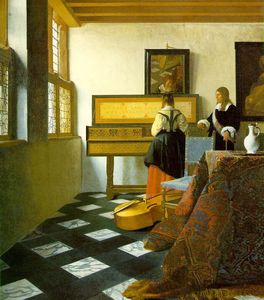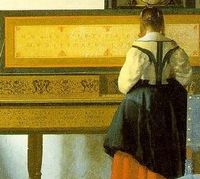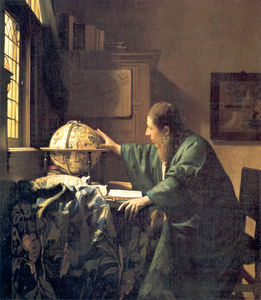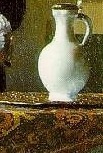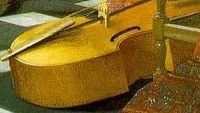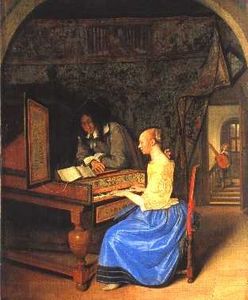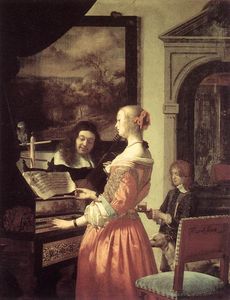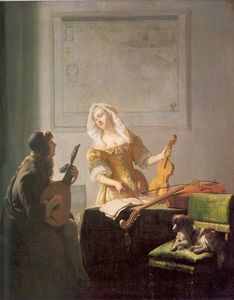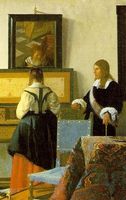The Music Lesson
- Date of Creation:
- 1664
- Alternative Names:
- De muziekles
- Height (cm):
- 73.30
- Length (cm):
- 64.50
- Medium:
- Oil
- Support:
- Canvas
- Subject:
- Scenery
- Art Movement:
- Baroque
- Created by:
- Current Location:
- London, United Kingdom
- The Music Lesson Page's Content
- Story / Theme
- Inspirations for the Work
- Analysis
- Related Paintings
- Artist
- Art Period
- Bibliography
The Music Lesson Story / Theme
This work is one if Vermeer's greatest depictions of Dutch culture during the 17th century. In this image we see a young lady having a music lesson playing the virginal, a keyboard instrument. Virginals were commonly played by young ladies and they produced a delicate, fine sound which was appropriate for women of this time.
The music composed for the virginal always told of moral values and enlightenment but also spoke of romance, love and happy adventures within the virtues of religious order.
The Music Lesson is from a wealthy upper-class scene, as it was common practice for women from affluent families to partake in such activities. Vermeer's idealism is evident in this canvas, as he paints yet another depiction based on women's role in society and what he sees as righteous and beautiful.
The viewer is left to imagine the narrative taking place and can create the music filling the scene. Vermeer inserts various other instruments to reinforce a musical theme, such as the viol on the floor.
The identities of the sitters are unknown but the gentleman here also appears in The Geographer. It is debatable whether the gentleman is the teacher to the student. This same figure appears again in another of Vermeer's works, The Astronomer.
The Music Lesson Inspirations for the Work
In The Music Lesson we can see the influence of Caravaggio, obviously derived from Vermeer's time at the Guild of St Luke. In the top right hand corner of the canvas we see a faded painting that depicts one of the acts from 'The seven acts of mercy ', featuring Cimon and her father Pero. This image reinstates Vermeer's love of classicism and the Italian baroque style.
This act of Cimon shows the soft nature that is attributed to femininity. Overall, this picture symbolizes the reinforcement of women's role as a merciful being unto others. It could also represent her expectations as caregiver and caretaker of the family throughout her life.
The Music Lesson Analysis
Composition:
The compositional technique used here creates a flow of movement as the viewer gazes across the image. Vermeer uses many techniques to create a strong three-dimensional effect in this work.
The foreground objects direct the eye up to the subjects situated at the back. The gentleman's' gaze also encourages focus as the viewer is directed to the young lady.
The foreground objects serve to determine distance and perspective. The partial presence of Vermeer's easel stand can even be seen in the leaning mirror's reflection, so we truly observe this scene as the artist himself did.
Use of light:
Shadows create depth as it travels in and around the objects in the room. Light fills this scene and can be seen between the roof beams, between the strings of the viol and in the folds of the fabric.
The mirror is painted in a darker tone as it faces downward, missing the filtering light. Vermeer does this in excellent painting style with exact execution.
Object such as the jug, gilded plate and chair tacks are painted under the camera obscura which helps to better define the light source in the room. Objects help to intensify shadows, demonstrated in the corner of the virginal and behind the gentleman.
Brushstroke:
Delicate daubing is used for the wall surface to create texture and show the effect of the light on it. The artist's smooth lines for the pitcher portray its fragility and the wet surface.
Wood textures such as the viol and chair legs take on smoother brush strokes in more linear definition. The virginal's texture shows a glossy finish. The feel of the wood depicted here can even entice smell as the polished surface is brought into focus.
The floor tiles show how Vermeer applies the paint thinly and more roughly, daubing to show its refined pattern and composition. It was also an excellent method in recreating its reflective surface and shine.
Color Palette:
The Persian carpet is painted very precisely and intense layers of oranges, reds and browns emphasize its heaviness and strength.
The windows are defined by soft brown ochres that are tinted. The ochre painted sections show the windows pane's reflection and presence protruding from the outside as well as the outside wall's brick work. Vermeer uses soft yellow and brown ochres for the outside lighting.
However, he uses blue tones for the lighting coming inside the room and experiments with a subtle earth green under painting for the bottom half of the wall on the left hand side.
The Music Lesson Related Paintings
The Music Lesson Artist
Vermeer was a realist painter who focused on chiaroscuro and became a master of this technique. He delighted in the technicalities of the camera obscura and was an avid fan of using various lens and glass contraptions to discover new forms of capturing light in various contexts. This is particularly obvious in The Music Lesson.
Although Vermeer held nothing original in his artistic interpretation and subject matter, he was extremely skilled in creating superb pieces of art. His work allows the viewer to be more active in the viewing process and this is clearly demonstrated in The Music Lesson. Vermeer does not create a specific narrative in his works like his contemporaries but rather concentrates on the moment itself and the rest of the story is created by the observer.
This work is considered one of Vermeer's greatest depictions of Dutch culture during the 17th century.
The Music Lesson Art Period
Dutch Baroque has become the most noted era in art and it was the most lavish style in the history of Europe's figurative arts. Artists were able to freely choose their subject matter and how they wanted to express it and this resulted in artist excelling in creating new art styles and techniques.
Baroque art came into play at a time when the foundations of capitalism were being laid by the world's growing economies and art was expanding in new and exciting directions.
New national schools were opening across Europe but there was already a dominate style, spearheaded by great masters, such as Caravaggio, Poussin, Bernini and Rubens who provided inspiration for many emerging artists.
Vermeer was an idealist who strived to bring out the beauty in the most mundane aspects of daily life and his unique skill made him a leader and revolutionary of the Baroque era.
The Music Lesson Bibliography
To read more about Vermeer and his work please refer to the recommended reading list below.
• Arasse, Daniel. Vermeer: Faith in Painting. Princeton University Press, 1996
• Binstock, Benjamin. Vermeer's Family Secrets: Genius, Discovery, and the Unknown Apprentice. Routledge, 2008
• Cant, Serena. Vermeer and His World: 1632-1675. Quercus, 2009
• Liedtke, W. Vermeer and the Delft School (Metropolitan Museum of Art). Yale University Press, 2001
• Snow, E. A Study of Vermeer. University of California Press, 1994
• Steadman, Philip. Vermeer's Camera: Uncovering the Truth Behind the Masterpieces. Oxford Paperbacks; New Ed edition, 2002

